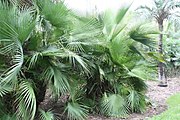Brahea dulcis
| Brahea dulcis | |
|---|---|
 | |
| In the wild, Mexico | |
 | |
| Base of trunk | |
| Scientific classification | |
| Kingdom: | Plantae |
| Clade: | Tracheophytes |
| Clade: | Angiosperms |
| Clade: | Monocots |
| Clade: | Commelinids |
| Order: | Arecales |
| Family: | Arecaceae |
| Tribe: | Trachycarpeae |
| Genus: | Brahea |
| Species: | B. dulcis |
| Binomial name | |
| Brahea dulcis | |
| Synonyms[2] | |
| List
| |
Brahea dulcis, the sweet hesper palm or apak palm, is a species of flowering plant in the family Arecaceae.[3] It is native to dry woodlands of Mexico, Guatemala, Belize, El Salvador, and Honduras.[2] A single-trunked palm reaching 7.5 m (25 ft) with edible fruit and green to blue-green leaves, it is occasionally available from commercial suppliers.[3][4]
References
[edit]- ^ Quero, H.; López-Toledo, L. (2015). "Brahea dulcis". IUCN Red List of Threatened Species. 2015: e.T55948562A55948580. doi:10.2305/IUCN.UK.2015-2.RLTS.T55948562A55948580.en. Retrieved 28 January 2024.
- ^ a b "Brahea dulcis (Kunth) Mart". Plants of the World Online. Royal Botanic Gardens, Kew. Retrieved 28 January 2024.
- ^ a b "Brahea dulcis sweet Hesper palm". rhs.org.uk. The Royal Horticultural Society. 2024. Retrieved 28 January 2024.
Other common names; rock palm ... 1 suppliers
- ^ Fern, Ken (20 July 2022). "Useful Tropical Plants Brahea dulcis". tropical.theferns.info. Tropical Plants Database. Retrieved 28 January 2024.
Common Name: Apak Palm


 French
French Deutsch
Deutsch
